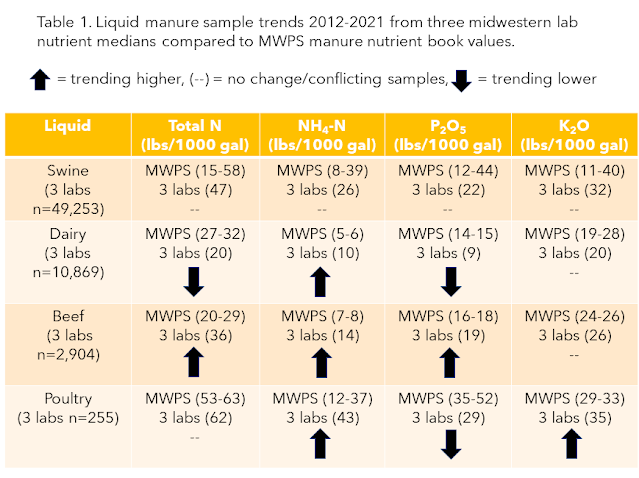
Key Points
- Current livestock manure “book values” (the approximate amounts of various nutrients in manure) are several decades old.
- Using recent data from several Midwest U.S. labs, we found that manure nutrient data have changed over time compared to previous Midwest Plan Service (MWPS) manure book values.
- The University of Minnesota is creating a manure nutrient database called ManureDB to help update these values.
- We are currently looking to partner with laboratories that analyze manure on this project.
What we did
Why do we care about manure? Manure is an organic fertilizer that contains essential plant nutrients. However, it can be a variable product, making it a challenge to match plant nutrient needs to the amount of nutrients in the manure. Like commercial fertilizers, we also need to be aware of the risk of losing nitrogen (N) and phosphorus (P) and affecting water quality.
What are manure nutrient “book values”? These nutrient averages are used for developing manure management plans, designing manure storages, creating best management practices for manure land application, and agricultural modeling. They show a range of nutrient values that can be expected from typical manure storages and encourage farmers to test their manure often. However, current book values are several decades old and may not reflect current production practices. Different animal diets, genetics, housing, and manure storage and handling practices can impact these manure nutrient values.
We are working with the Minnesota Supercomputing Institute to develop a manure nutrient database called ManureDB to create more accurate manure nutrient book values. In preparation for this project, we partnered with three Midwest U.S. laboratories to share data from approximately the last ten years. We compared those manure sample results to the estimated manure nutrient book values in Manure Characteristics published in 2004 by Midwest Plan Service (MWPS). We wanted to see if there were any nutrient trends and identify ways to make ManureDB useful and user-friendly.
We compared the nutrient averages of beef, dairy, poultry, and swine manure in both the liquid and solid forms. These are fairly generic comparisons as we did not have any details on animal housing, manure storages, or animal age. We converted the lab results and book values into pounds of nutrient per ton for solid manure and pounds of nutrient per 1,000 gallons of liquid manure. We used the median value for total nitrogen (N), ammonium-nitrogen (NH4-N), phosphorus (P2O5), and potassium (K2O) to look at the major nutrients needed for crop production.
What did we find?
Some of our results did differ from the MWPS published book values as shown in Tables 1 and 2 below. Without knowing swine age or manure storage systems, it was difficult to determine nutrient level changes for swine liquid manure. For liquid dairy manure samples, we found a decreasing trend over time for total N and P2O5 and an increasing trend in NH4-N. For liquid beef manure samples, we found an increasing trend for total N, NH4-N, and P2O5. For liquid poultry manure samples, we found an increasing trend for NH4-N and K2O and a decreasing trend for P2O5.
For solid swine, dairy, and beef manure samples, we found an increasing trend for total N, P2O5, and K2O. For solid poultry manure samples, we found an increasing trend for total N and K2O.
In the future, more details about the manure samples will make comparisons even more helpful. We know animal age, nutrition, housing, and manure storage and handling can impact manure nutrient levels.
What’s next?
Additional information
- ManureDB website: http://manuredb.umn.edu/ (coming soon!)
- U of M manure management research group
- Minnesota Supercomputing Institute
Acknowledgments
For the latest nutrient management information, subscribe to the Nutrient Management Podcast wherever you listen and never miss an episode! And don’t forget to subscribe to the Minnesota Crop News daily or weekly email newsletter, subscribe to our YouTube channel, like UMN Extension Nutrient Management on Facebook, follow us on Twitter, and visit our website.










